4-Wavelength High-Power LED Source
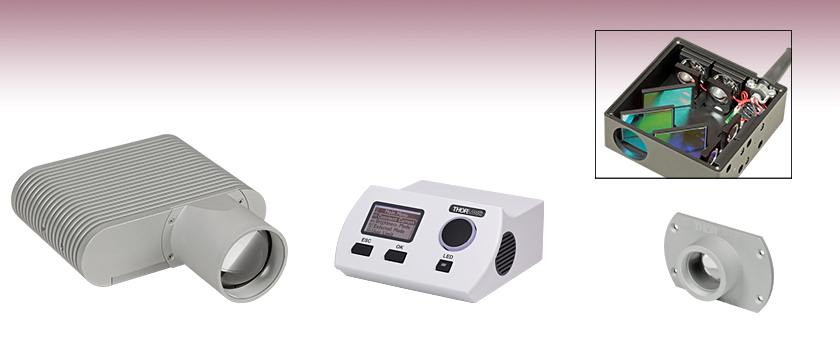
- 4-Wavelength LED Source with Stable and Repeatable Emission
- LED Switching Controlled via Current
- Choose from 14 LEDs
- Liquid Light Guide and Microscope Adapters Available
LED4D067
4-Wavelength High-Power LED Source
Ideally Operated by
DC4100 or DC4104 Drivers
LED4B1
Adapter to Couple
Liquid Light Guides to
the 4-Wavelength Source
Internal View of a 4-Wavelength Source

Please Wait
| LED Options | ||
|---|---|---|
| Nominal Wavelength |
Color (Click for Spectrum) |
Min LED Output Powera |
| 365 nm | UV | 85 mW |
| 385 nm | UV | 95 mW |
| 405 nm | UV | 290 mW |
| 420 nm | Violet | 95 mW |
| 455 nm | Royal Blue | 310 mW |
| 470 nm | Blue | 250 mW |
| 490 nm | Blue | 50 mW |
| 505 nm | Cyan | 170 mW |
| 530 nm | Green | 100 mW |
| 565 nm | Green Yellow | 106 mW |
| 590 nm | Amber | 65 mW |
| 617 nm | Orange | 210 mW |
| 625 nm | Red | 240 mW |
| 660 nm | Deep Red | 210 mW |
| General Specifications | |
|---|---|
| Operating Temperature Rangea | 0 °C to 40 °C (32 °F to 104°F) |
| Storage Temperature Range | -40 °C to 70°C (-49 °F to 158 °F) |
| Dimensions (W x H x D) | 164 mm x 150 mm x 57 mm (Without Cable) (6.46" x 5.91" x 2.24") |
| Front Aperture Thread | Internal SM2 (2.035"-40) |
| Weight | 1.6 kg (3.5 lbs) |
| Wavelength Combinations | ||||||||||||||
|---|---|---|---|---|---|---|---|---|---|---|---|---|---|---|
 |
 |
 |
 |
 |
 |
 |
 |
 |
 |
 |
 |
 |
 |
|
| 365 nm | X | X | X | X | ||||||||||
| 385 nm | X | X | X | X | ||||||||||
| 405 nm | X | X | X | X | ||||||||||
| 420 nm | X | X | X | X | ||||||||||
| 455 nm | X | X | X | |||||||||||
| 470 nm | X | X | X | |||||||||||
| 490 nm | X | X | X | X | ||||||||||
| 505 nm | X | X | X | X | ||||||||||
| 530 nm | X | X | X | |||||||||||
| 565 nm | X | X | X | X | ||||||||||
| 590 nm | X | X | ||||||||||||
| 617 nm | X | X | ||||||||||||
| 625 nm | X | X | X | |||||||||||
| 660 nm | X | X | ||||||||||||
Wavelength Combinations
Each LED4D source contains four individual high-power bare LEDs. Use the configurator below to build your LED4D 4-wavelength source by choosing from the 14 available LEDs listed in the table to the right. Due to the optical configuration, certain wavelengths cannot be combined within the same source. As you select each wavelength in the configurator, unavailable wavelength pairs will be excluded from each consecutive drop down menu.
Additional limitations imposed by the full configuration are outlined in the table to the right. Each combination of two wavelengths that cannot be included in the same 4-wavelength source is marked in grey, while available combinations are indicated by a green- or orange-shaded cell. The latter denotes a wavelength pair where the selection of the final two LEDs is further limited: LEDs with wavelengths below 455 nm cannot be included in an LED4D source with 660 nm, 617 nm, and 590 nm or 565 nm as the other three wavelengths. The configurator below is designed so that you cannot order a source with an unavailable wavelength configuration.
| Legend | ||
|---|---|---|
|
Unavailable Wavelength Combination | |
|
|
Available Wavelength Combination | |
|
|
Limited Combinations Availablea | |
Features
- User-Configurable 4-Wavelength Source
- Switching and Intensity Adjustments via LED Current Settings
- Better Stability and Longer Life than Gas Discharge and Halogen Lamps
- No Moving Parts for Vibration-Free Operation
- Cooling Fins Provide Efficient Thermal Management
- Long Lifetime Light Source (See the LED Specs Tab for Details)
- Optional Adapters for Olympus, Nikon, Zeiss, and Leica Microscope Lightports
- Optional Adapter for Coupling to Liquid Light Guides (LLGs)
The LED4D 4-Wavelength High-Power LED Sources are ideal for applications requiring up to four wavelengths of light. These user-configurable light sources efficiently combine the output of all four LEDs into a single collimated beam. Together with a DC4100 or DC4104 4-Channel LED Driver, the LED4D provides a reliable, versatile light source with LED switching and accurate intensity modulation of each individual LED. The source is vibration free, easy to operate, and has a long lifetime (see the Specs tab for details).
Compared to conventional non-LED sources such as halogen and gas discharge lamps, these 4-wavelength sources offer many advantages such as higher signal-to-noise ratios (due to narrow bandwidth emission), better stability, longer life, lower replacement costs, simple operation without maintenance cycles, and no active cooling requirements or thermal filtering due to minimal thermal loads. The LED current can be adjusted to quickly set the intensity via the DC4100 or DC4104 driver (sold separately) front panel or USB connection, making this source an ideal choice for microscopy applications where multiple wavelengths are required. The source can also be modulated using an external trigger connection on the DC4100 or DC4104 (see the full web presentation of these drivers for details).
The LEDs incorporated into these sources are characterized by high divergence. The light is guided through the system using mirrors, and the output is collimated with an aspheric condenser lens. This setup inherently leads to a reduction in the measured output power (as seen in the table to the right) compared to that of the bare LEDs. Thorlabs also offers single-channel collimated LEDs, which have higher power outputs since wavelength-combining optics are not needed.
Adapters
Optional adapters are available for using the 4-wavelength LED source with liquid light guides or microscopes. The output aperture of these LED sources is internally SM2 (2.035"-40) threaded. For Olympus, Nikon, Zeiss, and Leica microscopes, SM2-threaded adapters are available that directly mount the 4-wavelength sources onto the microscope lightport (see SM2-Threaded Microscope Adapters). See below for a video that demonstrates how to install the source on an Olympus microscope.
Alternatively, the LED4B1 Adapter for Liquid Light Guides (LLGs) is used to couple light exiting the LED source into a LLG. It replaces the SM2-threaded output port with an aperture that is internally SM1 (1.035"-40) threaded. The adapter contains an optic designed to focus light into the aperture of a LLG held by the appropriate LLG-to-SM1 adapter (AD3LLG for Ø3 mm core LLGs or AD5LLG for Ø5 mm core LLGs). More information on these adapters and Thorlabs' selection of liquid light guides can be found here.
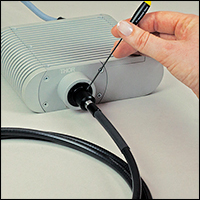
Click to Enlarge
The LED4B1 Adapter is used to couple light from the 4-wavelength LED source into a LLG held in a LLG-to-SM1 adapter.
| Nominal Wavelength |
Color (Click for Spectrum) |
Minimum LED Output Powera | Maximum Current (CW) | Forward Voltage | Bandwidth (FWHM) | Typical Lifetime |
|---|---|---|---|---|---|---|
| 365 nm | UV | 85 mW | 700 mA | 4.4 V | 7.5 nm | >10,000 h |
| 385 nm | UV | 95 mW | 700 mA | 4.3 V | 10 nm | >10,000 h |
| 405 nm | UV | 290 mW | 1000 mA | 3.8 V | 13 nm | 100,000 h |
| 420 nm | Violet | 95 mW | 1000 mA | 3.5 V | 15 nm | >10,000 h |
| 455 nm | Royal Blue | 310 mW | 1000 mA | 3.2 V | 18 nm | 100,000 h |
| 470 nm | Blue | 250 mW | 1000 mA | 3.2 V | 25 nm | 100,000 h |
| 490 nm | Blue | 50 mW | 350 mA | 3.5 V | 27 nm | >10,000 h |
| 505 nm | Cyan | 170 mW | 1000 mA | 3.3 V | 30 nm | 100,000 h |
| 530 nm | Green | 100 mW | 1000 mA | 3.2 V | 33 nm | 100,000 h |
| 565 nm | Green Yellow | 106 mW | 1000 mA | 3.1 V | 104 nm | 50,000 h |
| 590 nm | Amber | 65 mW | 1000 mA | 2.2 V | 18 nm | 100,000 h |
| 617 nm | Orange | 210 mW | 1000 mA | 2.2 V | 18 nm | 100,000 h |
| 625 nm | Red | 240 mW | 1000 mA | 2.2 V | 18 nm | 100,000 h |
| 660 nm | Deep Red | 210 mW | 1200 mA | 2.5 V | 25 nm | >65,000 h |
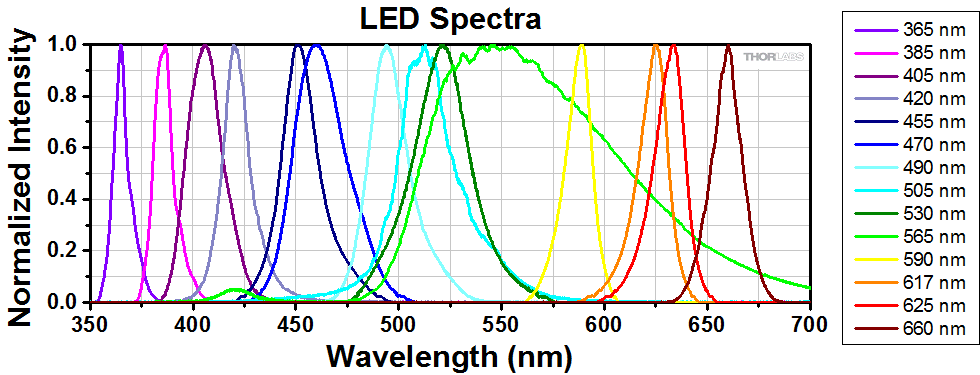
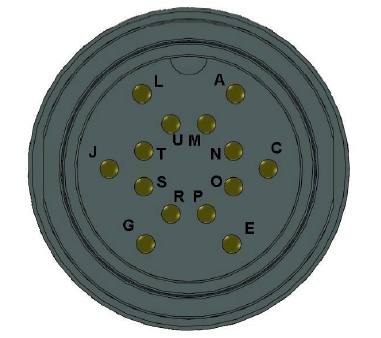
The LED4D has a flying lead terminated in a 14-pin M16 plug that is compatible with the DC4100 and DC4104 4-channel LED drivers. In the table below, LED A, LED B, LED C, and LED D denote each LED included in the source, ordered from shortest to longest wavelength.
| Pin | Description | Comment |
|---|---|---|
| A | LED1 Anode | - |
| C | LED1 Cathode | - |
| E | LED2 Anode | - |
| G | LED3 Anode | - |
| J | LED3 Cathode | - |
| L | LED4 Anode | - |
| M | LED1 1 Wire EEPROM I/O | Do Not Use |
| N | DGNG | Do Not Use |
| O | Not Connected | - |
| P | LED2 Cathode | - |
| R | Not Connected | - |
| S | Not Connected | - |
| T | Not Connected | - |
| U | LED4 Cathode | - |
Thorlabs' 4-Wavelength LED Source can be made compatible with our Liquid Light Guides (LLGs) with the addition of the LED4B1 adapter. The animation to the right and the text below detail the installation process.
Remove the SM2-threaded (2.035"-40) output port that comes installed on the 4-wavelength source by unscrewing the four M2.5 screws. Position the LED4B1 over the output of the 4-wavelength source so that the M2.5 counterbores line up with the tapped holes on the LED source housing. Use the M2.5 screws that came with the LED source to fasten the adapter in place.
Screw an SM1-to-LLG adapter (either the AD3LLG or AD5LLG, not included) into the SM1-threaded (1.035"-40) exit port of the LED4D1, and plug your LLG into the adapter. Tighten the setscrew on the side of the SM1-to-LLG adapter using a 0.05" hex key to secure the LLG in place.
| Posted Comments: | |
Alfredo Del Rio
(posted 2021-07-23 21:29:53.693) Hi,
The download for this LED Head is only the shell. We are planning to use only the internal optical components in a microscope we are designing. Can you provide a STEP file (or similar) of the internal assembly that I can import into SolidWorks?
Thank you soswald
(posted 2021-07-28 04:51:20.0) Dear Alfredo,
thank you for your feedback. Please contact your local tech support team so we can discuss your application in more detail and provide the necessary assistance. Peng Jun
(posted 2021-04-12 14:52:29.56) Hi, may I select two IR LED source (780nm and 880nm)to be integrated within your 4-Wavelength LED Source? Please let me know. Thank you! MKiess
(posted 2021-04-14 08:12:42.0) Dear Peng, thank you very much for your inquiry. We have the possibilities to manufacture, this 4-wavelength high-power LED source, with further wavelengths here as a special design. I have contacted you directly to discuss further details with you. Atanu Bag
(posted 2020-11-12 20:58:57.98) Hi, can we use one wavelength at a time?? Or, all channel (4 wavelength) will be activated during operation. wskopalik
(posted 2020-11-13 04:03:43.0) Dear Atanu,
Thank you very much for your inquiry!
Yes, you can also just use one wavelength at a time. Each LED can be individually controlled on the LED drivers. There is just one limitation on the DC4100 driver. All activated LEDs are controlled by the same modulation signal on this driver but can be individually deactivated. For the DC4104 controller however, each LED is controlled by a separate modulation signal, all of which are provided through a single, included cable. So if you want to control each LED individually by external modulation the DC4104 would be the best solution.
I will contact you directly to provide further assistance. user
(posted 2020-06-11 11:42:07.233) Hi! I am really interested in buying the 4-LED module with wavelength 470 nm, 530 nm, 590 nm, and 625 nm. For my application, the spectral bandwidth needs to be smaller than 10 nm so I wonder in front of each LED we can insert a bandpass filter. This filter will be before the dichroic mirror so it only affects each individual LED. I am completely aware that the intensity will be reduced. I would prefer to order it with this modification. However, I am happy to do this change by myself. Any feedback? dpossin
(posted 2020-06-15 06:41:16.0) Dear Customer! Thank you for your feedback. Unfortunately due to the limited space inside the LED4D housing we can not apply any additional optics in front of the LEDs. gmcnama2
(posted 2018-10-31 09:33:15.147) Dear ThorLabs,
with respect to your LED4D067 = 4-wavelength high power LED source (aka "4LED"), can:
* LEDs be moved by me between two 4LED sources?
** if no, can I custom specify what LEDs go in each of two units ... and work with you to specify beam combiners?
* do you offer a "merge module" to combine outputs of two 4LED sources (before going to LLG or back of microscope)?
thanks,
George nreusch
(posted 2018-11-09 10:08:24.0) This is a response from Nicola at Thorlabs. Dear George, thank you for your inquiry! We can offer to change the LED configuration of the 4-wavelength LED source as service, but we strongly recommend sending the source to us, as we need to readjust the LED source. Unfortunately, we do not offer a universal merge module, but you might be able to use a beam combiner for this purpose. Please contact your local Tech Support team for further information. xuy
(posted 2018-09-06 01:42:17.573) Hi, may I select a IR LED source (730nm-970nm)to be integrated within your 4-wavelength high power LED source?
Please let me know. Thank you! Best regards, Yingshun XU swick
(posted 2018-09-12 04:10:04.0) This is a response from Sebastian at Thorlabs. Thank you for the inquiry.
We can offer customized 4-Wavelength High-Power LED Sources.
I contacted you directly to provide assistance. fs417
(posted 2018-06-28 11:01:55.777) I was wondering whether it is possible to have an excitation filter installed directly inside the LED combiner before the combining dichroics. Especially the 565nm LED is extremely broad, so I would like to filter it beforehand. nreusch
(posted 2018-07-04 09:32:17.0) This is a response from Nicola at Thorlabs. Thank you very much for your inquiry. Unfortunately, the effort for this modification would be very high. I will contact you directly in order to check whether there might be an easier alternative for your application. mauro.biagi
(posted 2017-11-16 14:49:40.0) What about rise-fall times of these LEDs? mvonsivers
(posted 2017-11-21 03:40:18.0) This is a response from Moritz at Thorlabs. Thank you for your inquiry. Unfortunately, we do not specify the rise/fall times for our LEDs, therefore, we can not guarantee any values. In general, you can expect the rise/fall time to be shorter than 2-3 µs.
We will contact you directly for further assistance. l.volkers
(posted 2017-03-03 06:05:12.103) Could you please provide the maximum light irradiations (in mW/mm2) for the following wavelengths: 470 nm, 530 nm, 590 nm, 625 nm? I want to incorporate the LED source in an Olympus BX51WI microscope with a 10x and 40x objective and want ot be sure that I can cover a 0 to ~15mW/mm2 irradiation range. Thanks swick
(posted 2017-03-07 03:09:38.0) This is a response from Sebastian at Thorlabs. Thank you for the inquiry.
Unfortunately, the objectives you are using are not mentioned so we can not apply this measurement.
We could send you a loan device of LED4D for testing purposes.
Unfortunately, you did not left contact details on the feedback form.
Please contact europe@thorlabs.com, for further assistance. eddie.ross
(posted 2016-10-03 11:45:08.86) Could you please provide information about the RGB mixing ratios / drive currents in order to achieve white light output from this LED source? Thanks swick
(posted 2016-10-04 04:02:42.0) This is a response from Sebastian at Thorlabs. Thank you for the inquiry.
Unfortunately, the four wavelength LED source is not designed to emit white-light based on superimposing four LEDs.
The spatial profile of intensity is non-constant, which makes it impossible to achieve proper white-light over the full clear aperture.
I will contact you directly to discuss alternatives. thobra
(posted 2016-09-26 06:21:29.427) Hi. I am interested in knowing wheather this LED unit may be controlled by micromanager (www.micro-manager.org)? It is not on the list, but might be compatible to some other driver. We already have an old LUDL control unit for the stage that is controlled by micromanager. Thanks swick
(posted 2016-09-27 10:47:20.0) This is a response from Sebastian at Thorlabs. Thank you for the inquiry.
The 4-Channel LED-Drivers (DC4100 and DC4104), which are used to control the 4-Wavelength High-Power LED Source, are compatible to micromanager. I have contacted you directly with more detailed information how this can be done. eddie.ross
(posted 2016-07-29 15:50:42.387) Could you provide some information on how well collimated the beam is?
Thanks swick
(posted 2016-08-02 09:12:43.0) This is a response from Sebastian at Thorlabs.
Thank you very much for your inquiry. At the moment we unfortunately cannot provide information on divergence of the output beams emitted by LED4D231.
I have contacted you directly to discuss the needs and expectations of your application. saharv
(posted 2016-05-24 03:57:54.873) The 4-Wavelength High-Power LED Source could be very useful for my project but it could been even better if it had white broad band LED in the available selection list.
If there is any update in this parameter, I'll be happy to add broad white LED to the light source I'm planning to purchase for my lab.
Thanks,
Sahar shallwig
(posted 2016-05-25 04:21:10.0) This is a response from Stefan at Thorlabs. Thank you very much for your feedback. With our currently available 4 wavelength LED system from its design with built dichroic mirrors it is not possible to create a white broadband output spectrum. We will take your feedback into consideration for the development of next generation multi-color LED systems.
At the moment we can offer the MBB1L3 broadband LED. pain
(posted 2013-11-04 10:30:27.457) could you provide with a reference for the electrical connectors ( 14points cylindrical) ?
thanks tschalk
(posted 2013-11-11 03:40:06.0) This is a response from Thomas at Thorlabs. Thank you very much for your inquiry. The name of the connector is IEC 130-9 (http://www.binder-connector.com/en/products/924?onserie=1 ). I will contact you directly with more detailed information. pain
(posted 2013-09-25 12:19:10.653) I would like to know the output power at the exit of a 3 or 5 mm Liquid Light guide associated to the 470nm, 530,590,625nm leds.
thanks tschalk
(posted 2013-10-15 04:52:00.0) This is a response from Thomas at Thorlabs. Thank you very much for your inquiry. This information is provided in the table on our web site: http://www.thorlabs.com/newgrouppage9.cfm?objectgroup_id=3836&pn=LED4B1#7320. tschalk
(posted 2012-12-21 06:20:00.0) This is a response from Thomas at Thorlabs. Thank you very much for your inquiry. Unfortunately we do not have this information but I will be very happy to simulate it for you. I will contact you with more detailed information. Best Regards, Thomas mhawks
(posted 2012-12-19 13:29:54.733) Do you have any specifications on how well-collimated the beam is? tschalk
(posted 2012-12-19 10:26:00.0) This is a response from Thomas at Thorlabs. Thank you very much for your inquiry. It is possible to integrate an excitation filter into the 4 Wavelength High-Power LED Source. This filter will influence all four wavelengths. I will contact you directly for more detailed information. Best Regards, Thomas tschalk
(posted 2012-12-19 09:50:00.0) This is a response from Thomas at Thorlabs. Thank you very much for your inquiry. Unfortunately we do not have a setup yet were it is possible to couple light from a 4-color LED source into a liquid light guide. However, you could use a lens tube, for example SM2L30, with an aspheric condenser lens, for example ACL5040-A. The lens tube fits into the SM2 threading on the 4-color LED source. To mount a liquid light guide you can use two adapters, SM2A6 and AD5LLG. It is a good idea to have a complete setup with an aligned lens. I will forward this idea to our development department so that we will be able to offer a part like this in the future. Best Regards, Thomas heyderc
(posted 2012-12-18 15:20:11.607) I would also like to know if it is possible to fit excitation filters into the LED source. Thanks. heyderc
(posted 2012-12-18 17:31:48.753) I would like to know if the 4-color LED source can be coupled to a liquid light guide. Thanks, Chris tschalk
(posted 2012-11-14 06:29:00.0) A response from Thomas at Thorlabs: Thank you for your inquiry! The lower power is caused through losses inside the housing. The divergence of the LED-Chips is very high and the beam is guided with mirrors to the condenser lens for collimation. Because of this setup a lot of optical energy gets lost. The lens of a single collimated LED is located directly in front of the LED-Chip and this causes almost no losses. eozkan
(posted 2012-11-12 21:47:25.213) Hello,
Could you help me understand why power measurements on 4 wavelength high power led source are much lower single wavelength collimated led sources?(compare 470 for example: 25 mW on this product vs. >800 if purchased seperately)
thanks, jvigroux
(posted 2012-06-20 10:04:00.0) A response from Julien at Thorlabs: Thank you for your inquiry! This should be in principle possible but will largely depend on the exact combination of wavelengths you need. I will contact you directly to see which possible combination would work best for you dario.protti
(posted 2012-06-20 01:11:26.0) would it be possible to use 3 LEDs in the visible range and one infrared (~850nm)? many thanks in advance jvigroux
(posted 2012-01-26 07:37:00.0) A response from Julien at Thorlabs: Thank you for your inquiry! The LEDs will yield about the same spectral irradiance as a HOB mercury lamp. The LED however will have wider spectral distribution than the individual mercury lamps such that their efficiency will also depend on the width of the fluorescent proteins you use. I will contact you directly to further discuss those points ron.goldstein
(posted 2012-01-24 11:44:04.0) I would like to use this light source for live imaging of cells with fluorescent proteins GFP/mCherry etc.
I currently use a 100W HBO mercury lamp and exciter filters. How does the INTENSITY of the light from this LED source compare to that of at mercury lamp at 455/590/627?
Thanks jvigroux
(posted 2011-12-19 13:09:00.0) a response form Julien at Thorlabs: Thank you for your feedback! the design of the LED4C LED source only allows the simultaneous use of four different wavelengths. Further, there is to our knowledge no high power LED available at 340nm. We should discuss more closely what the exact requirements for your application are as based on the exact output power required, there might be some other type of setup allowing to achieve the wavelength combination you need. Unfortunately, for now the use of the software within MetaMorph/MetaFluor is not yet implemented. The suggestion to emulate the Sutter filter wheel seems like a goop approach. Our software engineers are having a look into this and I should be able to post further information about the feasibility of such approach within the next 2-3 weeks. gmcnamara
(posted 2011-12-16 19:03:14.0) I would like to use a 4LED - or better yet 5LED - for Fura-2 Calcium ion ratio imaging, plus GFP, DsRed and Cy5/Alexa Fluor 647 (not necessarily at one time). I will need:
~340 nm LED (in addition to 385, 470, 530 and hopefully 627 LEDs).
specific bandpass filtes to eliminate the tails of the LED spectra - especially so that I can have a clean separation of ~340 nm from ~385 nm light.
I can select the appropriate filter sets for inside my microscope, once you/I/we figure out the LED bandpass filters. Probably a Fura-2 + Cy5 filter set and a DAPI/Green/Red triple pass set.
I find your 4LED + microscope adapter product selection line-up on your web site confusing.
I need more useful software integration than uManager. You never posted a follow-up to the 2009-11-24 posting about third party software. I am especially interested in MetaMorph/MetaFluor. If you do not want to work with vendors one by one, a suggstion: consider emulating a Sutter 10-2 filter wheel and shutter, with USB control (you can use the uManager Sutter interface to test the emulation). bdada
(posted 2011-11-08 10:53:00.0) Response from Buki at Thorlabs:
Thank you for your interest in our 4 wavelength LED source. We will contact you for more information about your applications and the options for customization of the unit. richard.norman
(posted 2011-11-07 18:25:14.0) Interested in using it for a different application, but I'm having difficulty determining the output levels. May need different output optics. Can they be changed? Contact me and I'll explain the application. jvigroux
(posted 2011-08-10 11:48:00.0) A response from Julien at Thorlabs: Thank you for your feedback. As of now, we do not have dichroic mirrors that allow to cover the necessary spectrum for the combination you need (from 450nm to 850nm). This is the main reason why the maximum wavelengths for those four colors LEDs is about 670nm. Maybe an different arrangement using single LEDs could also work for your application. I will contact you directly to discuss this approach. pbenzel
(posted 2011-08-09 11:53:30.0) Can a LED4C1 be ordered with the following wavelengths 455, 530, 627, 850nm? bdada
(posted 2011-04-26 12:14:00.0) Response from Buki at Thorlabs:
Thank you for your feedback. The DC4100 controller allows you to switch on all 4 LEDs at once. Please refer to page 11 of the DC4100 manual linked below to learn more about the multi selection mode:
http://www.thorlabs.com/Thorcat/18300/18321-D02.pdf
You can also access the manual and other technical documents for each product on our website. If you have any questions, please contact TechSupport@thorlabs.com. michael.halter
(posted 2011-04-26 10:25:40.0) Can the light from all four LEDs be output at the same time (such that I could filter all light in the microscope body)? jjurado
(posted 2011-03-15 08:46:00.0) Response from Javier at Thorlabs to Karl Farrow: I will contact you directly to discuss your application. karl.farrow
(posted 2011-03-15 11:14:36.0) Im very interested in purchasing this product but with a different set of mounted LEDs.
Could you please contact me to discuss if this is possible.
Thanks
Karl Farrow julien
(posted 2010-12-08 05:22:39.0) A response from Julien at Thorlabs: Dear Shin-young, the LED4CX have an internal SM2 thread on which the microscope adapters LED4AX can be directly mounted. I will contact you directly to see exactly what the problem with your adapter is. ryusy123
(posted 2010-12-07 07:06:28.0) I purchased LED4C and olympus adapter but I cannot find the right way to mount this LED4C with the olympus adapter LED4A1.
my microscope is olympus IX71.
Please let me know how to mount
Thank you.
Shin-Young Ryu egentzsch
(posted 2009-11-24 16:42:30.0) A response from Erik at Thorlabs to lhall: This driver has its own software (Graphical User Interface) and software drivers. Currently it supports only the software µManager. I will check if it is possible to integrate it into third party software. lhall
(posted 2009-11-20 08:48:06.0) Hi again,
Forgot to ask if this system will work with Metamorph, Slidebook or Olympus SIS software or other software.
Please advise.
Lance R. Hall
Leeds lhall
(posted 2009-11-20 08:44:57.0) Has this been used for fluorescent application, most noteably for GFP and CFP.
thanks,
Lance R. Hall
Senior Technical Sales
Leeds Instruments, Inc.
San Antonio, Texas
Cell: (210) 421 4953 |
This tab includes all LEDs sold by Thorlabs. Click on More [+] to view all available wavelengths for each type of LED pictured below.
| Light Emitting Diode (LED) Selection Guide | ||||||
|---|---|---|---|---|---|---|
| Click Photo to Enlarge (Representative; Not to Scale) |
 |
 |
 |
 |
 |
 |
| Type | Unmounted LEDs | Pigtailed LEDs | LEDs in SMT Packages |
LED Arrays | LED Ring Light | Cage-Compatible Diffuse Backlight LED |
| Light Emitting Diode (LED) Selection Guide | ||||||
|---|---|---|---|---|---|---|
| Click Photo to Enlarge (Representative; Not to Scale) |
 |
 |
 |
 |
 |
 |
| Type | PCB- Mounted LEDs |
Heatsink- Mounted LEDs |
Collimated LEDs for Microscopyb | Fiber- Coupled LEDsc |
High-Power LEDs for Microscopy | Multi-Wavelength LED Source Optionsd |

To access the item #, documentation, and pricing for a 4-wavelength source, select four wavelengths in the configurator below. Pricing is identical regardless of the combination chosen, but item # will vary.
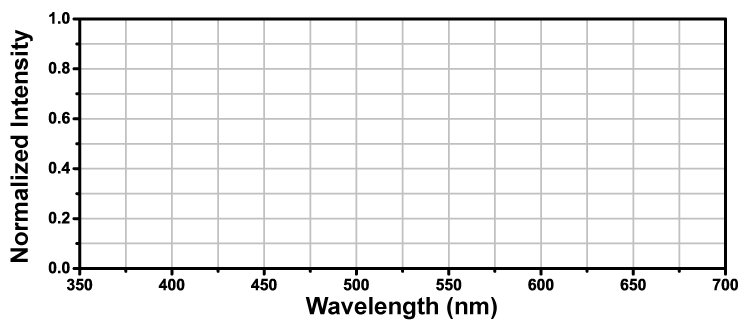




| Choose your LEDs: | |||
| LED 1 | nm | ||
| LED 2 | nm | ||
| LED 3 | nm | ||
| LED 4 | nm | ||

These SM2-threaded mounting adapters allow the 4-wavelength LED source to be mounted on an Olympus, Leica, Nikon, or Zeiss Microscope. The video to the right demonstrates how to install the source on an Olympus microscope.
| Item # | LED4A1 | LED4A2 | LED4A4 | LED4A5 |
|---|---|---|---|---|
| (Click Photo to Enlarge) |  |
 |
 |
 |
| Compatible Microscope | Olympus BX or IX | Leica DMI | Zeiss Axioskop | Nikon Eclipse Ti |

| Output Power of 4-Wavelength LED Source with LED4B1 and LLG Attached | |||||
|---|---|---|---|---|---|
| LED Nominal Wavelength |
Power through LLG (Typ.) | LED Nominal Wavelength |
Power through LLG (Typ.) | ||
| Ø3 mm Core, 6' (1.8 m) Long |
Ø5 mm Core, 4' (1.2 m) Long |
Ø3 mm Core, 6' (1.8 m) Long |
Ø5 mm Core, 4' (1.2 m) Long |
||
| 365 nm | 35 mW | 110 mW | 505 nm | 70 mW | 150 mW |
| 385 nm | 65 mW | 120 mW | 530 nm | 15 mW | 55 mW |
| 405 nm | 110 mW | 330 mW | 565 nm | 57 mW | 93 mW |
| 420 nm | 15 mW | 63 mW | 590 nm | 20 mW | 45 mW |
| 455 nm | 105 mW | 250 mW | 617 nm | 80 mW | 150 mW |
| 470 nm | 105 mW | 275 mW | 625 nm | 100 mW | 200 mW |
| 490 nm | 10 mW | 30 mW | 660 nm | 100 mW | 190 mW |
The LED4B1 Adapter for Liquid Light Guides contains an aspheric lens (Item # ACL2520-A) to focus light from the 4-wavelength LED source into a liquid light guide (LLG). The adapter is SM1-threaded and requires a separate SM1-to-LLG adapter (sold separately). We offer the AD3LLG SM1 Adapter for Ø3 mm Core LLGs and the AD5LLG SM1 Adapter for Ø5 mm Core LLGs. Thorlabs' selection of liquid light guides can be found here.
The table to the right shows the output power of the 4-channel LED with the LED4B1 adapter. The adapter, which contains only one lens, replaces the two lenses and ground glass diffuser included in the 4-channel LED head. Thus, The LLG adapter provides less attenuation compared to the free-space output of the 4-wavelength LED source alone. Therefore, the output powers provided in the table to the right will differ from those specified with the standard 4-channel LED head.
The LED4B1 has the same bolt pattern as the the 4-wavelength source's SM2-threaded collimating output port. To install, simply remove the SM2-threaded output port by unscrewing the four M2.5 screws and attach the LED4B1 adapter in its place using the same four screws. Then thread in the LLG adapter and install the LLG. Detailed installation instructions may be found on the LLG Installation tab above.
 Products Home
Products Home













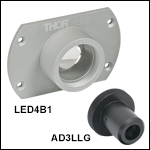
 Zoom
Zoom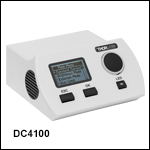
 4-Wavelength High-Power LED Source
4-Wavelength High-Power LED Source